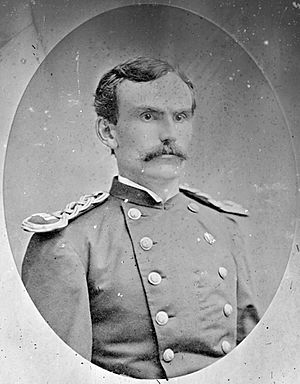George Edwin Lord facts for kids
Quick facts for kids
George Edwin Lord
|
|
|---|---|
 |
|
| Born | February 17, 1846 Brunswick, Maine |
| Died | June 25, 1876 (aged 30) Montana |
| Allegiance | United States of America |
| Service/ |
United States Army |
| Years of service | 1875–76 |
| Rank | Assistant Surgeon |
| Unit | 7th U.S. Cavalry |
| Battles/wars | American Indian Wars |
George Edwin Lord (February 17, 1846 – June 25, 1876) was a brave doctor who served in the United States Army. He was an Assistant Surgeon with the 7th U.S. Cavalry. Sadly, he was killed during the famous Battle of the Little Big Horn in Montana. This battle was part of the Black Hills War.
Contents
Who Was George Edwin Lord?
George Edwin Lord was an important figure in the U.S. Army. He was a doctor who helped soldiers. His life ended during one of the most well-known battles in American history.
Early Life and Education
George Lord was born in Brunswick, Maine on February 17, 1846. He was a bright student. He went to college at Bowdoin College. After that, he studied medicine to become a doctor.
Joining the Army
After finishing medical school, Dr. Lord decided to serve his country. He moved west to work for the U.S. Army. He was stationed at different forts and outposts. In January 1875, he signed another contract with the Army. He became a first lieutenant in the 7th Cavalry. His unit was based at Fort Abraham Lincoln in the Dakota Territory.
The Battle of the Little Bighorn
In 1876, Dr. Lord joined Lieutenant Colonel George Armstrong Custer's group. They were heading towards the Little Bighorn River. This was during the Great Sioux War of 1876. On June 25, 1876, a major battle happened there. It is now known as the Battle of the Little Bighorn. Dr. Lord was killed during this battle.
A Mystery on the Battlefield
After the battle, soldiers tried to identify the dead. Dr. Lord's body was not clearly identified at first. General Alfred Terry initially listed him as missing. However, two officers, Captain Otto E. Michaelis and Lieutenant Richard E. Thompson, believed they saw his body. They contacted Dr. Lord's brother. They recognized him by a blue shirt, his hands, mustache, and general look. Michaelis also thought the socks on the body were from a set Dr. Lord had bought. Based on this information, General Terry later changed Dr. Lord's status. He was then officially listed as killed in action.
Remembering Dr. Lord
Today, there is no specific marker for Dr. Lord at the Little Bighorn Battlefield National Monument. However, in 1890, a marker was placed for him. It was put on the South Skirmish Line. This spot was chosen because buttons thought to be from a staff officer's uniform were found there. Doctors often wore such uniforms. Dr. Lord's surgical kit was later found by Native Americans. It was then sent to the Army's medical museum.

